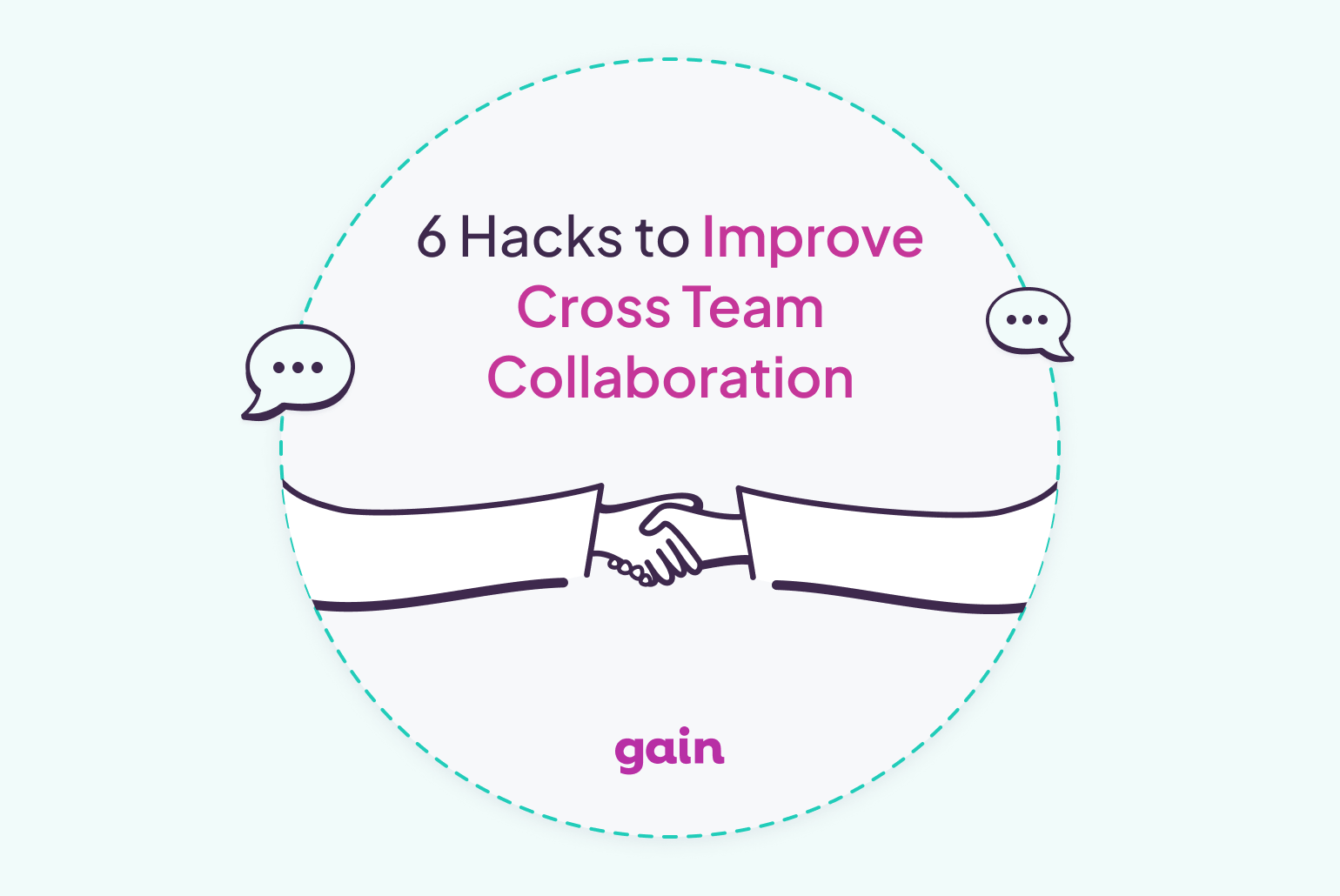Sometimes we have to work with another team. Say you’re on the social media team at an insurance company. Before you put out your social media posts, you need to get them reviewed by the legal department to ensure they comply with your country’s laws.
Or, let’s say you’re working on a new marketing campaign. Your team is in charge of the strategy, but you also need to work with the research department to gather customer insights and the public relations team to craft press releases and manage media outreach, ensuring everything runs smoothly.
Whatever the scenario, cross-team collaboration is very common. However, it’s not always successful due to poor communication and lack of organization.
Here’s how to perfect cross-team collaboration initiatives and turn them from dysfunctional to winning.
To Start, What Exactly Is Cross-Team Collaboration?
Cross-team collaboration (or cross-functional collaboration) is when people from different groups or departments in a company work together on a project or routinely.
Working together is common in many workplaces. For example, creating a new product might require ideas from the marketing team, the design team, and the sales team. Coming to work together helps them combine their skills and knowledge to create the best possible result.
Common Challenges of Cross-Functional Collaboration
Different teams working together sounds good—on paper.
Most organizations have a long way to go before they can easily coordinate between departments. Let’s unpack some typical challenges these teams might face:
- Communication Silos — Communication silos in cross-functional teams occur when departments or groups only communicate within their own unit and not with others. This isolation can lead to a lack of shared information, redundant work, and misaligned goals.
- Conflicting Goals — Each team might prioritize things differently. For example, marketing might focus on creativity, while legal prioritizes compliance. This can lead to a lack of alignment.
- Unclear Jobs — When teams come together, people might not know exactly what they’re supposed to do. Without defined roles, tasks can be duplicated or missed. According to a McKinsey Survey, 40% of respondents believe that unclear roles and responsibilities add unnecessary complexity within organizations.
- Different Work Styles — Teams might have different ways of doing things. This can lead to conflict when one team prefers quick decisions, while another requires thorough analysis.
So, how do you overcome these hurdles? Let’s explore six ways to make the most out of cross-departmental collaboration.
6 Hacks to Improve Cross-Team Collaboration
1. Start With the Basics
Let’s kick things off with the basics – because without a solid foundation, everything else crumbles. There’s a reason why teams need to come together. You might need to work on developing a new product or improving your customer service. It can be anything. Management needs to identify and lead the cross-team collaboration efforts.
Here are the basic things cross-departmental teams need to agree on:
- The Purpose of Inter-Departmental Collaboration: Why are we working together? Management should explain the big goals so everyone knows the mission.
- Joint Goals: What specific objectives are we aiming to achieve? Everyone should know the clear, measurable goals that support the main purpose.
- Clearly Defined Roles and Responsibilities: Who is doing what? Management should outline each team member’s role and responsibilities to avoid overlap and confusion.
- Expectations: What do we expect from each other? Set clear expectations regarding communication, deadlines, and deliverables.
2. Centralize Communications in One Place
Communication is what makes or breaks cross-functional teams. As we said before, one of the challenges these teams face is siloed communications. When this happens, you can expect overlap and duplication of efforts since team members aren’t aware of what other departments are doing.
Here’s what you need to do to tackle this issue head-on:
- Use a single communication platform
- Organize channels within your chosen platform
- Share regular updates on your progress
- Schedule regular check-ins
- Over-communicate for clarity
Centralizing communication helps make sure nothing gets lost and everyone stays on the same page—literally.
3. Invest in Collaboration Tools
The thing about cross-team collaboration is that technology can overcome most of the challenges these teams face. Investing in collaboration tools that are fit for purpose can streamline your workflows and keep the team organized and accountable.
If your cross-functional team manages many projects, consider platforms like Trello, Asana, or Monday.com. You might also want to explore document-sharing tools such as Google Drive, Dropbox, and Microsoft OneDrive. And if you have frequent meetings, definitely invest in solutions like Zoom or Microsoft Teams.
While these tools are built for a wide range of use cases, you can find specific solutions tailored to your unique needs.
For example, if you’re in social media marketing, our tool, Gain, can be a great choice. Gain is designed to streamline content approval processes, making it easier for teams to collaborate on marketing materials and social media posts. Here’s how Gain can help your team:
Centralized Collaboration: Gain connects all marketing roles and teams in one place. This means social media and advertising creatives can share assets and content seamlessly. Team members can assign tasks, and account managers can track people’s progress, ensuring that everyone is on the same page.
Role-Specific Permissions: Assign appropriate roles for team members, such as publishers, contributors, or approvers. This ensures that everyone has the right level of access and can only see or do what they’re meant to.
Tasks: Assigning tasks in cross-team collaboration can be confusing when you’re using lots of different tools and platforms to communicate. With Gain, it’s easy. You can assign tasks to your team members right alongside the content you’re working on. They’ll get notified and have their own list of tasks to do. As soon as they finish a task, they can check it off their list.
Approval Workflows: Gain offers automated approval workflows with unlimited stakeholders. You can create detailed workflows with internal and external revision rounds. Content automatically moves to the next person for review, making the process efficient and organized. These workflows work amazingly well when it comes to getting your content approved by the legal team internally or by your clients if you’re an agency.
4. Do Brainstorming Sessions Together
Brainstorming sessions are key for cross-functional teams. They bring everyone together to share ideas and solve problems. The main benefit? Combining different perspectives leads to creative solutions.
Brainstorming can be extremely effective when your company faces an issue involving your cross-departmental team. Bringing your team together for a brainstorming session can help uncover hidden problems and allow every team member to be heard without any judgment.
5. Improve Tacit Knowledge Capture and Exchange
Tacit knowledge is the know-how gained through experience. It’s often hard to capture and share because it lives in people’s heads, not in documents, but it’s crucial for teamwork and productivity.
You need to find ways to capture this knowledge. You don’t want a skilled team member to leave your company one day with all their know-how, leaving the rest of the team without it.
Start by encouraging sharing through informal meetings, lunch-and-learn sessions, or team-building activities. Use tools to document processes and store them in an accessible place. For example, ask a team member once or twice a month to write down the steps of one particular task they do.
Mentorship programs are also helpful. Pair experienced employees with newer ones for hands-on guidance. Regular training sessions where team members share recent projects, challenges, and solutions can also be very effective.
6. Implement a Continuous Feedback Loop
Finally, gather feedback from your team. You can either hold weekly or bi-weekly meetings where everyone shares updates and challenges or use feedback tools like surveys or apps for anonymous input to reveal hidden issues that people might not feel comfortable sharing in front of others.
Feedback should be seen as something positive, so remind everyone that it helps you grow together.
The Bottom Line
Improving cross-team collaboration can seem challenging, but with the right strategies and tools, it’s definitely achievable.
If you’re looking for a tool that makes social media content collaboration easy, check out Gain.
Hop on a free trial now (no credit card required).






